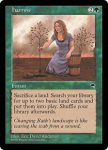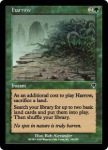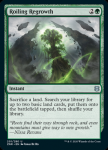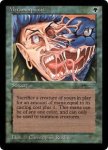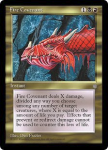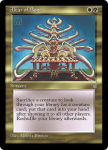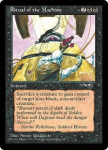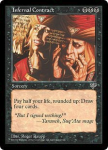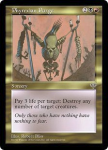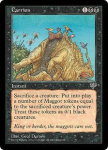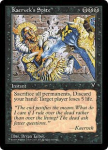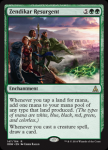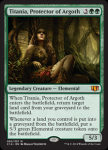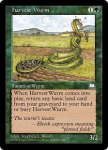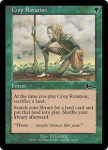Oversoul
The Tentacled One
At the beginning of the thread for Seasons Past, I noted that my extensive EDH deckbuilding efforts of the past few years and my dabbling in Canadian Highlander have been my only outlet for experience with some of the "new" cards in the game. Going through my most-played cards in EDH for 2019 and 2020, I noticed a card I wanted to talk about, but it's certainly not new. And I've been using it a whole lot lately, but it's not at all new-to-me either. In fact, my memories of Harrow go back to before I had a very good grasp of the game. It might have been the first Tempest card I actually played with.
While playing EDH in local groups, and really in all sorts of other context when people are playing Magic, the topic of when people started playing often comes up. And I always tell everyone that I started in 1997 with the first Portal set. In fact, I have a vague memory of going with my mom to a game store looking for Warhammer miniatures and the game store owner showing me marketing materials for the new introductory product before it had actually hit the shelves. So I think I actually opened up Portal within a week or so of the set's official May 1, 1997 release date. The thing that always bugged me about telling that little story was that I couldn't seem to remember much, if anything, about actually playing Magic in 1997. Wait, it sounds weird when I put it like that. "Some stuff happened decades ago but I'm having trouble remembering the details." Shocking, right? No, that's not what I mean. And I'm struggling to explain why this would be important to me, but let me reminisce about some examples and I think that I can make it more apparent why I'd care in the first place. So, here are some of my memories from Magic in 1998...
Well, yesterday, something unexpected jogged my memory. I happened to stumble across a picture related to my uncle's wedding, which was on June 19th, 1998. I was obsessing over Magic around that time (Exodus would have just come out, but I think I wasn't spending any money and didn't pick up any cards from the set at the time). I had checked out books from the library; during the car rides to and from the wedding, I was engrossed in the Distant Planes anthology of Magic stories. So yesterday I found myself thinking back to reading that book, and it suddenly occurred to me that it was also at this time that I added City of Brass and some other nonbasic lands to my multicolored decks. I'd probably recently acquired some of my first Fifth Edition cards. The basic concept of mana-fixing was already known to me at this point, but my collection of still-mostly-Portal cards had almost nothing to actually fix my mana. I had stuck mostly to monochromatic decks, and perhaps my lack of mana-fixing was part of the reason for this. But I understood the value of access to multiple colors and I was excited to use my newly acquired City of Brass.
And all this led me down the train of thought about that City of Brass. My first. I still miss that City of Brass. Not sure what happened to it, but I know from my recent card sort that I no longer own a Fifth Edition copy of the card. I should pick one up at some point. I tried to think back to what kind of deck I'd put City of Brass into. I know that I eventually put it in my "SQ" deck, but that wasn't until 1999, and this was June of 1998. I realized, somewhat disappointed, that of course I was remembering a generic five-color pile of all my favorite cards crammed into one deck, lacking any cohesion. It might not even have been 60 cards. I was still pretty bad at the game in 1998! So, the deck itself was garbage, but I recalled enough to have an idea of what I'd been running before the summer of 1998. You see where this is going?
That garbage pile of cards was the one I'd had going ever since I first acquired cards from outside the Portal starter set. It was the typical new player "deck of all the cards in my collection that I think are cool." That was why it lacked cohesion. It was the same thing any new player does if not given guidance on how to actually make decks better. And as soon as I picked up mana-fixing, it went in. Because when you're running five colors, you work with whatever fixing you can. I didn't own dual lands or even pain lands. But I did have a few fixing cards here and there. The memories came flooding back to me. Mogg Hollows and Rootwater Depths. Lousy cards, but I guess they were "My First Mana-Fixing." And alongside them there was Untamed Wilds, Mana Prism, and Harrow.
My next thought was, "Hey that's cool. I guess I was using Harrow as far back as 1997." This was followed by, "Oh no, I was using Mana Prism back in 1997." Like I said, you work with whatever fixing you can.
I have to chuckle a bit, realizing that up until last night, the last time I thought of Harrow as primarily being a fixing card instead of primarily being a ramp card must have been around June of 1998, when I pulled it from that five-color deck. Still, Harrow is technically mana-fixing. It's actually pretty good at the task.
While playing EDH in local groups, and really in all sorts of other context when people are playing Magic, the topic of when people started playing often comes up. And I always tell everyone that I started in 1997 with the first Portal set. In fact, I have a vague memory of going with my mom to a game store looking for Warhammer miniatures and the game store owner showing me marketing materials for the new introductory product before it had actually hit the shelves. So I think I actually opened up Portal within a week or so of the set's official May 1, 1997 release date. The thing that always bugged me about telling that little story was that I couldn't seem to remember much, if anything, about actually playing Magic in 1997. Wait, it sounds weird when I put it like that. "Some stuff happened decades ago but I'm having trouble remembering the details." Shocking, right? No, that's not what I mean. And I'm struggling to explain why this would be important to me, but let me reminisce about some examples and I think that I can make it more apparent why I'd care in the first place. So, here are some of my memories from Magic in 1998...
- Getting a Fifth Edition 2-Player Starter set and reading through the included rulebook cover-cover-to cover multiple times.
- Throwing a bunch of red damage-dealing spells together to construct my Burn deck, which I continued to upgrade and kept together to this day, although virtually every individual card has been swapped out at some point. I think that the copies of the card Fireblast are the exact same ones I was using in 1998. Everything else is almost certainly different.
- Getting Stronghold booster packs, which might have been the first individual booster packs I bought. And Stronghold became one of my favorite sets.
- Buying grab-bags of old bulk cards at the game store and getting my first copies of Force of Will in those $1 bags.
- Playtesting my decks against a stack of 300+ old bulk cards (with basic lands in the mix) and trying to figure out some of those old cards as I was seeing them for the first time. In one of those games, my deck (which wasn't my best deck, thankfully), lost because it couldn't deal with Scaled Wurm.
- Buying a bunch of Fallen Empires packs because they were super-cheap, and then trying to figure out how to actually build decks with those weird cards. I built a whole deck around Tidal Influence because I liked the art and because it was confusing enough for me to trick myself into thinking that it was a good card.
- Getting Polar Kraken and trying to build decks that could somehow use this amazing 11/11 creature!
- Getting a bag of rubber bands so that I could wrap them around my decks to keep them separate.
- Reading in Scrye magazine that Necropotence was supposed to be a good card, so I started using it because I owned a copy and figured I'd figure out what was so good about it (I actually think I picked up on that pretty quickly). My use of Necropotence + Ivory Tower might actually date all the way back to 1998.
- Trading for some of my favorite Unglued cards because I thought they were really cool, but didn't have much money to spend on packs.
- Searching, unsuccessfully, for a copy of Thing from the Deep. I guess I just really wanted to play big creatures and sacrifice my own land.
- Figuring out that I'd made several of my decks worse by putting in Ice Age cards that had cumulative upkeep.
- Sorting my entire collection in little piles underneath an old stone table in my bedroom.
- Building a deck in every color and playing them against each other in a tournament.
- Reading about the "Emperor" multiplayer format and struggling to wrangle enough friends to play it.
- My devastating combo of Rolling Stones + Illusionary Wall.
- Figuring out that if I made myself discard a card, I could discard a big creature (like Polar Kraken!) and then use Animate Dead on it.
- Seeing "gold" cards for the first time and trying to pick them up in different color pairings so that I could build decks around them. They were gold, so they had to be special. Turned out Sivitri Scarzam wasn't very good.
- Getting a bunch of Urza's Saga stuff for my birthday. It was revolutionary for me. Urza's Saga was the greatest set in existence. Maybe it still is.
- Turning the "Tombstone" precon into my own blue/black control deck that became my favorite among my own casual decks for years to come. I loved the art and style of this precon and it was legitimately a better deck than anything I'd built myself up to that point. Refining "Tombstone" was basically how I learned to build real Magic decks instead of nonsensical newbie piles. Also, the use of Power Sink in this deck led me to realize that I'd been playing interrupts incorrectly all along, and led to a frenzy of deck revisions as I incorporated interrupts into my decks.
- Turning the "The Plague" precon into my own Pestilence deck, another of my recurring casual decks that would evolve and live on for many years.
- When the owner of the game store where I was getting stuff for Warhammer Quest thought I might like Magic, he showed me a card. I think it was Teremko Griffin.
- Recruiting my 9-year-old sister to play through the scripted teaching game in the Portal starter set.
- Opening Capricious Sorcerer and Fire Dragon in the first booster packs I cracked. So of course, Fire Dragon was the powerhouse in one of the first decks I built for myself. I graciously allowed my 9-year-old sister to pilot the Fire Dragon deck and endeavored to beat her with the Capricious Sorcerer deck. She won. Since my deck had Snapping Drake and Wind Drake, she concocted an elaborate mythology surrounding the war between the drakes and the dragons, roping our younger brothers into playing with her in this fantastical drakes vs. dragons game. I think she was the high priestess of the dragons or something. She is now 33 and may or may not still be high priestess of the dragons.
- Going to the game store and seeing a lot of Ice Age cards. Having previously seen only Mirage, Fifth Edition, and Portal, I mistakenly believed that this was a new set. Someone corrected me on this misconception.
Well, yesterday, something unexpected jogged my memory. I happened to stumble across a picture related to my uncle's wedding, which was on June 19th, 1998. I was obsessing over Magic around that time (Exodus would have just come out, but I think I wasn't spending any money and didn't pick up any cards from the set at the time). I had checked out books from the library; during the car rides to and from the wedding, I was engrossed in the Distant Planes anthology of Magic stories. So yesterday I found myself thinking back to reading that book, and it suddenly occurred to me that it was also at this time that I added City of Brass and some other nonbasic lands to my multicolored decks. I'd probably recently acquired some of my first Fifth Edition cards. The basic concept of mana-fixing was already known to me at this point, but my collection of still-mostly-Portal cards had almost nothing to actually fix my mana. I had stuck mostly to monochromatic decks, and perhaps my lack of mana-fixing was part of the reason for this. But I understood the value of access to multiple colors and I was excited to use my newly acquired City of Brass.
And all this led me down the train of thought about that City of Brass. My first. I still miss that City of Brass. Not sure what happened to it, but I know from my recent card sort that I no longer own a Fifth Edition copy of the card. I should pick one up at some point. I tried to think back to what kind of deck I'd put City of Brass into. I know that I eventually put it in my "SQ" deck, but that wasn't until 1999, and this was June of 1998. I realized, somewhat disappointed, that of course I was remembering a generic five-color pile of all my favorite cards crammed into one deck, lacking any cohesion. It might not even have been 60 cards. I was still pretty bad at the game in 1998! So, the deck itself was garbage, but I recalled enough to have an idea of what I'd been running before the summer of 1998. You see where this is going?
That garbage pile of cards was the one I'd had going ever since I first acquired cards from outside the Portal starter set. It was the typical new player "deck of all the cards in my collection that I think are cool." That was why it lacked cohesion. It was the same thing any new player does if not given guidance on how to actually make decks better. And as soon as I picked up mana-fixing, it went in. Because when you're running five colors, you work with whatever fixing you can. I didn't own dual lands or even pain lands. But I did have a few fixing cards here and there. The memories came flooding back to me. Mogg Hollows and Rootwater Depths. Lousy cards, but I guess they were "My First Mana-Fixing." And alongside them there was Untamed Wilds, Mana Prism, and Harrow.
My next thought was, "Hey that's cool. I guess I was using Harrow as far back as 1997." This was followed by, "Oh no, I was using Mana Prism back in 1997." Like I said, you work with whatever fixing you can.
I have to chuckle a bit, realizing that up until last night, the last time I thought of Harrow as primarily being a fixing card instead of primarily being a ramp card must have been around June of 1998, when I pulled it from that five-color deck. Still, Harrow is technically mana-fixing. It's actually pretty good at the task.

